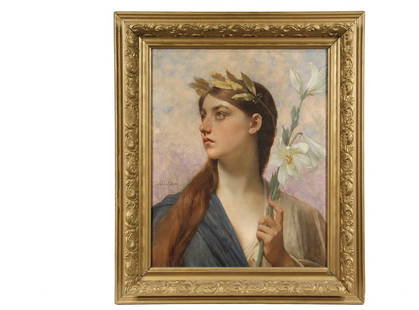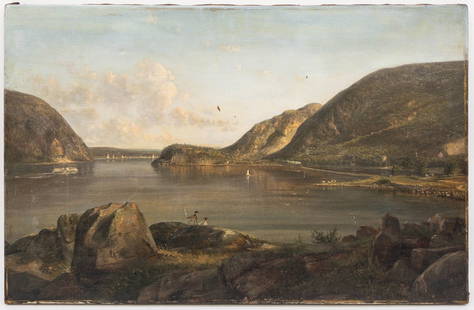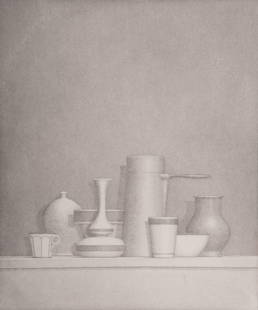
Melville T Wire Etching ” Ramona’s Marriage Place – San
Similar Sale History
View More Items in PaintingsRelated Paintings
More Items in Paintings
View More
Recommended Art
View More









Item Details
Description
16” x 20” framed, 8” x 11” print
Melville Wire was born in Austin, Illinois in 1877, and at age seven moved with his family to Salem, Oregon where his father became pastor of the First Methodist Episcopal Church. He and his father spent a lot of time together hunting and fishing, and spotting the son’s art talent, his father enrolled him in classes in Salem at Willamette University with Marie Craig. Studying with her until he was sixteen, Melville Wire found “his life-long love of drawing and painting” (126), which he combined with his increasing admiration of the Oregon landscape.
In 1895, Wire attended the University of Oregon, then called State University, and in 1897, transferred to Albany College in Albany, the predecessor to Lewis and Clark College in Portland. He studied for the ministry, and began that career in 1902 as a pastor in Glenview, Illinois. He was married for forty-seven years to Bessie Edna Burgess, and she later took up watercolor painting, learning techniques from her husband.
Wire was an exhibiting member of the Portland Art Club and the Oregon Society of Artists. In 1915, he exhibited with representative Oregon artists at the Panama-Pacific Exposition in San Francisco.
In 1935, Melville Wire took up etching, which he learned from Gordon Gilkey, a member of his congregation in Albany. From that time, Wire made over thirty plates that included abandoned barns and unpopulated landscape, often with dying trees. Many of Wire’s color reproductions were sold through a Chicago printer and through the Associated American Artists Gallery, a print club in New York. He exhibited his work with the Society of American Etchers and the National Society of Etchers as well as other venues.
After retirement in 1946, Wire and his wife moved to Salem, where he became very active in painting, lecturing and exhibiting. He painted in oils, took up watercolors and painted almost to the day of his death on June 22, 1962. He showed no interest in modernism, but stayed with his own impressionist style that reflected his love of the scenery of rural Oregon.
The Casa de Estudillo, also known as the Estudillo House, is a historic adobe house in San Diego, California, United States. It was constructed in 1827 by José María Estudillo and his son José Antonio Estudillo, early settlers of San Diego, and was considered one of the finest houses in Mexican California. It is located in Old Town San Diego State Historic Park, and is designated as both a National and a California Historical Landmark in its own right.Besides being one of the oldest surviving examples of Spanish architecture in California, the house gained much prominence by association with Helen Hunt Jackson’s wildly popular 1884 novel Ramona. The Casa de Estudillo is one of three National Historic Landmarks in Southern California that were closely tied to Ramona, a novel of Californio life shortly after the American acquisition of California; the other two are Rancho Camulos and Rancho Guajome.
ASSOCIATION WITH THE NOVEL
José Antonio Estudillo died in 1852, and his family stayed until 1887, when they moved to Los Angeles, leaving the house in the hands of a caretaker. Meanwhile, the 1884 publication of Ramona, a novel set in Southern California which painted a romanticized portrait of Californio life, generated a nationwide interest in the region. This, combined with the opening of the Southern Pacific and Santa Fe Railway lines (and the ensuing rate war,which drove prices down to as low as $1 from St. Louis, Missouri to Los Angeles, meant that hordes of tourists made their way to Southern California to see the locations in the novel. Unfortunately, Jackson died in 1885 without ever having disclosed what the actual locations in the novel were, which caused a great deal of speculation.
In 1937, with “Ramona’s Marriage Place” prominently visible. Note the missing cupola.
In 1887, a front page article of the San Diego Union declared the Estudillo home to be “Ramona’s Marriage Place”, saying, “To sleepy Old Town (the house) is known as the Estudillos, but the outside world knows it as the marriage place of ‘Ramona.'” This was despite Jackson never having visited the house, but in the novel, Ramona was married in a “long, low adobe building which had served no mean purpose in the old Presidio days, but was now fallen in decay; and all its rooms, except those occupied by the Father, had been long uninhabited”. Despite the novel being a work of fiction, visitors flocked to the building thinking it was the actual location of Ramona’s marriage. To be clear, the Union did not simply invent this story; a tourist had already scratched the name “Alessandro” (Ramona’s husband in the novel) in one of the walls. The caretaker decided to capitalize on the attendant publicity and began selling off pieces of the house as souvenirs. Naturally, the building’s condition began to deteriorate rapidly.
1910 RESTORATION
In 1906, the dilapidated building was purchased by the San Diego Electric Railway Company, owned by prominent San Diego citizen John D. Spreckels (who also owned the Union). In his vision, the house would anchor a number of tourist attractions connected via his railway which would realize his twin goals of developing San Diego into a popular locale and generate revenue for his company. To this end, he hired architect Hazel Wood Waterman to renovate the house to a condition more closely matching descriptions in the novel. The original cupola and balcony was removed because there was none mentioned in the novel, and several doors and windows were moved. Waterman was exacting in her specifications: She wanted the building to look aged as well as have the “charm of the work of half-skilled Indian hands”, although modern conveniences such as electricity and indoor plumbing were included. Upon its completion in 1910, it was marketed as a Ramona-related tourist attraction, and remained popular as such for years to come, drawing 1,632 visitors on one day in 1940.
Spreckels hired Tommy Getz, a theater showman, to manage the property, and it was under Getz’s guidance that the property truly gained its Ramona association. He began strongly marketing the property: Tchotchkes of all sorts were labeled with “Ramona’s Marriage Place”, and more postcards were printed for the adobe than any other Ramona attraction. Due to its association with Ramona’s marriage, the house was used to host weddings as well. Getz eventually purchased the adobe from Spreckels in 1924.
The association with the novel was so keen that the application for National Historic Landmark status was entitled, “Casa Estudillo/Ramona’s Marriage Place.” The Journal of San Diego History goes so far as to say that without the novel’s influence and the popularity of the house, the historic buildings that make up Old Town San Diego would have been razed. In fact, for a time, the Estudillos’ relationship to the house was nearly forgotten. After Getz’s death in 1934, his daughter Margeurite Weiss continued to operate the business for another thirty years, finally selling it 1964 to the Title Insurance and Trust Company, which then sold it to local businessman Legler Benbough, who donated it to the State of California in 1968.Provenance: Oregon Estate
This item ships from Los Angeles, CA.
Melville Wire was born in Austin, Illinois in 1877, and at age seven moved with his family to Salem, Oregon where his father became pastor of the First Methodist Episcopal Church. He and his father spent a lot of time together hunting and fishing, and spotting the son’s art talent, his father enrolled him in classes in Salem at Willamette University with Marie Craig. Studying with her until he was sixteen, Melville Wire found “his life-long love of drawing and painting” (126), which he combined with his increasing admiration of the Oregon landscape.
In 1895, Wire attended the University of Oregon, then called State University, and in 1897, transferred to Albany College in Albany, the predecessor to Lewis and Clark College in Portland. He studied for the ministry, and began that career in 1902 as a pastor in Glenview, Illinois. He was married for forty-seven years to Bessie Edna Burgess, and she later took up watercolor painting, learning techniques from her husband.
Wire was an exhibiting member of the Portland Art Club and the Oregon Society of Artists. In 1915, he exhibited with representative Oregon artists at the Panama-Pacific Exposition in San Francisco.
In 1935, Melville Wire took up etching, which he learned from Gordon Gilkey, a member of his congregation in Albany. From that time, Wire made over thirty plates that included abandoned barns and unpopulated landscape, often with dying trees. Many of Wire’s color reproductions were sold through a Chicago printer and through the Associated American Artists Gallery, a print club in New York. He exhibited his work with the Society of American Etchers and the National Society of Etchers as well as other venues.
After retirement in 1946, Wire and his wife moved to Salem, where he became very active in painting, lecturing and exhibiting. He painted in oils, took up watercolors and painted almost to the day of his death on June 22, 1962. He showed no interest in modernism, but stayed with his own impressionist style that reflected his love of the scenery of rural Oregon.
The Casa de Estudillo, also known as the Estudillo House, is a historic adobe house in San Diego, California, United States. It was constructed in 1827 by José María Estudillo and his son José Antonio Estudillo, early settlers of San Diego, and was considered one of the finest houses in Mexican California. It is located in Old Town San Diego State Historic Park, and is designated as both a National and a California Historical Landmark in its own right.Besides being one of the oldest surviving examples of Spanish architecture in California, the house gained much prominence by association with Helen Hunt Jackson’s wildly popular 1884 novel Ramona. The Casa de Estudillo is one of three National Historic Landmarks in Southern California that were closely tied to Ramona, a novel of Californio life shortly after the American acquisition of California; the other two are Rancho Camulos and Rancho Guajome.
ASSOCIATION WITH THE NOVEL
José Antonio Estudillo died in 1852, and his family stayed until 1887, when they moved to Los Angeles, leaving the house in the hands of a caretaker. Meanwhile, the 1884 publication of Ramona, a novel set in Southern California which painted a romanticized portrait of Californio life, generated a nationwide interest in the region. This, combined with the opening of the Southern Pacific and Santa Fe Railway lines (and the ensuing rate war,which drove prices down to as low as $1 from St. Louis, Missouri to Los Angeles, meant that hordes of tourists made their way to Southern California to see the locations in the novel. Unfortunately, Jackson died in 1885 without ever having disclosed what the actual locations in the novel were, which caused a great deal of speculation.
In 1937, with “Ramona’s Marriage Place” prominently visible. Note the missing cupola.
In 1887, a front page article of the San Diego Union declared the Estudillo home to be “Ramona’s Marriage Place”, saying, “To sleepy Old Town (the house) is known as the Estudillos, but the outside world knows it as the marriage place of ‘Ramona.'” This was despite Jackson never having visited the house, but in the novel, Ramona was married in a “long, low adobe building which had served no mean purpose in the old Presidio days, but was now fallen in decay; and all its rooms, except those occupied by the Father, had been long uninhabited”. Despite the novel being a work of fiction, visitors flocked to the building thinking it was the actual location of Ramona’s marriage. To be clear, the Union did not simply invent this story; a tourist had already scratched the name “Alessandro” (Ramona’s husband in the novel) in one of the walls. The caretaker decided to capitalize on the attendant publicity and began selling off pieces of the house as souvenirs. Naturally, the building’s condition began to deteriorate rapidly.
1910 RESTORATION
In 1906, the dilapidated building was purchased by the San Diego Electric Railway Company, owned by prominent San Diego citizen John D. Spreckels (who also owned the Union). In his vision, the house would anchor a number of tourist attractions connected via his railway which would realize his twin goals of developing San Diego into a popular locale and generate revenue for his company. To this end, he hired architect Hazel Wood Waterman to renovate the house to a condition more closely matching descriptions in the novel. The original cupola and balcony was removed because there was none mentioned in the novel, and several doors and windows were moved. Waterman was exacting in her specifications: She wanted the building to look aged as well as have the “charm of the work of half-skilled Indian hands”, although modern conveniences such as electricity and indoor plumbing were included. Upon its completion in 1910, it was marketed as a Ramona-related tourist attraction, and remained popular as such for years to come, drawing 1,632 visitors on one day in 1940.
Spreckels hired Tommy Getz, a theater showman, to manage the property, and it was under Getz’s guidance that the property truly gained its Ramona association. He began strongly marketing the property: Tchotchkes of all sorts were labeled with “Ramona’s Marriage Place”, and more postcards were printed for the adobe than any other Ramona attraction. Due to its association with Ramona’s marriage, the house was used to host weddings as well. Getz eventually purchased the adobe from Spreckels in 1924.
The association with the novel was so keen that the application for National Historic Landmark status was entitled, “Casa Estudillo/Ramona’s Marriage Place.” The Journal of San Diego History goes so far as to say that without the novel’s influence and the popularity of the house, the historic buildings that make up Old Town San Diego would have been razed. In fact, for a time, the Estudillos’ relationship to the house was nearly forgotten. After Getz’s death in 1934, his daughter Margeurite Weiss continued to operate the business for another thirty years, finally selling it 1964 to the Title Insurance and Trust Company, which then sold it to local businessman Legler Benbough, who donated it to the State of California in 1968.Provenance: Oregon Estate
This item ships from Los Angeles, CA.
Buyer's Premium
- 10%
Melville T Wire Etching ” Ramona’s Marriage Place – San
Estimate $400 - $500
1 bidder is watching this item.
Get approved to bid.
Shipping & Pickup Options
Item located in IL, CA, OH, TX, FL, NY, usSee Policy for Shipping
Payment

Related Searches
TOP

























































![Emilio Grau-Sala "Sur la Plage" Oil on Canvas: Emilio Grau-Sala (Spanish, 1911-1975), "Sur la Plage" [On The Beach], Oil on Canvas, 1958, signed "Grau Sala" lower right, signed, inscribed "Trouville", dated, and titled to verso. Image: 21.5" H x 2](https://p1.liveauctioneers.com/5649/328023/176731071_1_x.jpg?height=310&quality=70&version=1714409606)








![[SEX] LOT OF 9 PHOTOGRAPHS SOLD TOGETHER: [SEX] A lot of 9 photographs sold together. Some postcards. One mounted with plastic corners in archival mat. Prints: 4.5" x 3" - 6" x 4". Generally good condition, various imperfections. *Additional](https://p1.liveauctioneers.com/8124/329546/177689790_1_x.jpg?height=310&quality=70&version=1715469494)



